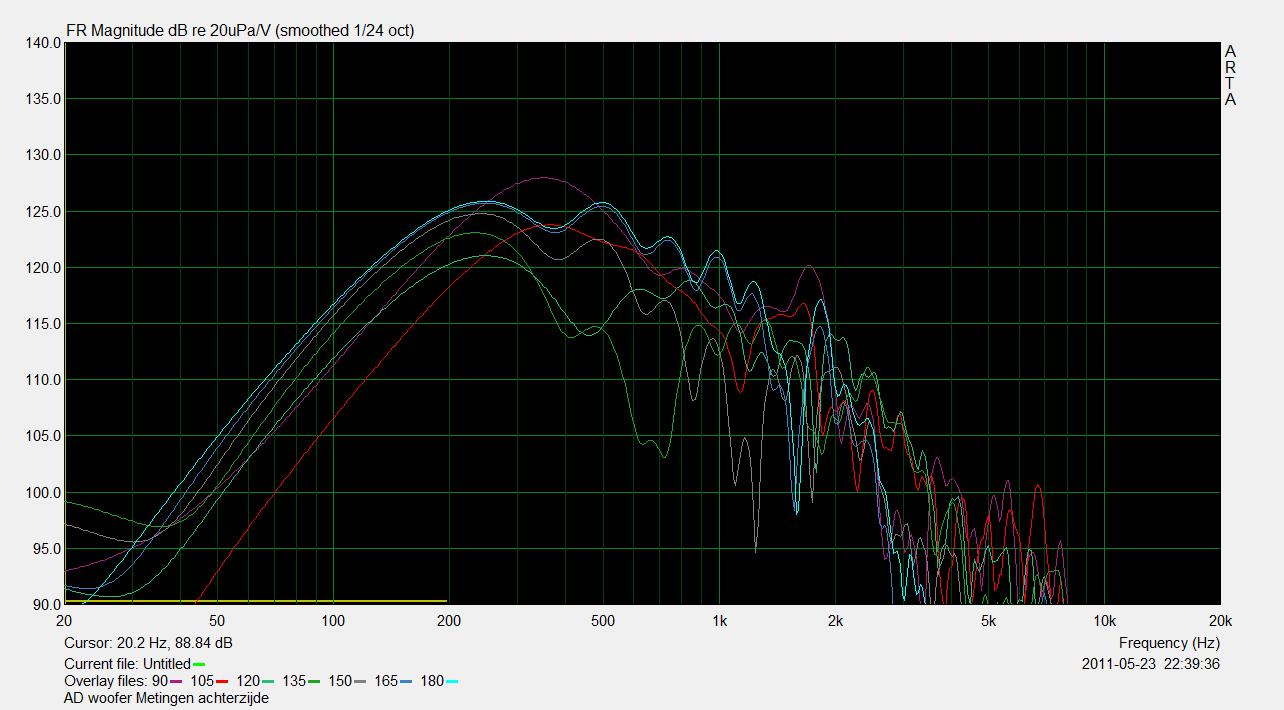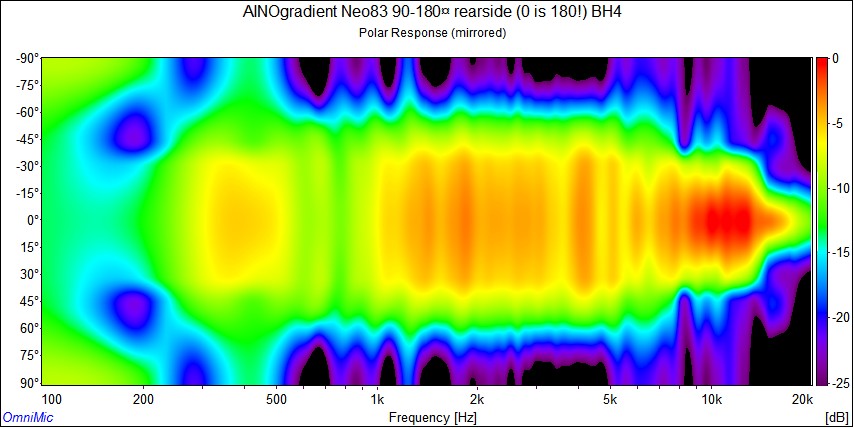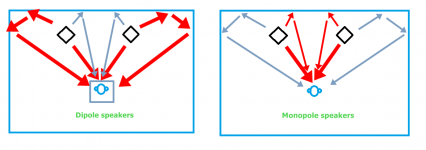Why not use the same speakers back to back?
That's a good question. It would give the best symmetry.
What logic leads to the belief that a dipole must be idenitcal front and back? At best that's a satisfying symmetry and some kind of helpful simplification for modelling.Why not use the same speakers back to back?
But it is a whole big question worthy of discussion about what should come out the back to enhance the front. The front, we all take for granted, should resurrect one channel of a stereo recording. But out the back and/or out the back and actually reaching the listener in his/her chair?
Conceptually, we could ask if you could measure the back wave while totally absorbing the front wave, what would you want to see.
B.
Which brings us back to the question posed in the first post and also what Matty was wondering about too, how much difference in the polar response is audible?
Ummmm…you might want to take another look at the measurements.… notion of how dipoles work - based on textbook physics - is misleading. There is little indication that the rear wave is sneaking around and cancelling the front wave*, at least in the band tested here and right to 80 degrees.

They follow theory pretty well:
- a gentle slope off in response for frequencies with wavelength > baffle size

- a gentle reduction in level as you go off-axis for frequencies with wavelength > baffle size

For reference, theory predicts 75deg of-axis reduction should be -11.7dB not complete cancellation.
What logic leads to the belief that a dipole must be idenitcal front and back? At best that's a satisfying symmetry and some kind of helpful simplification for modelling.
OK, then, show me a true dipole that is not symmetric!
Ben, this thread is about just that exact topic - dipole loudspeakers that have a symmetric response pattern at all frequencies. The question I would like to answer is: will a symmetric radiation pattern sound good or better than a non-symmetric one? I need to create a symmetric dipole from 20-20k, and then "take away" some of this by e.g. using a monopole tweeter above some frequency in place of the dipole one, to perform such an experiment. Thus, my interest in the subject.
But it is a whole big question worthy of discussion about what should come out the back to enhance the front.
The INTRODUCTION section from this web page has a very good overview of the hearing phenomenon, the precedence effect, and fusion of first arrival and echoes by the brain:
The precedence effect: Fusion and lateralization measures for headphone stimuli lateralized by interaural time and level differences
From the intro:
What "Echoes in agreement...fused with the direct sound" means is that non-direct sound that reflects off of the room and reaches the listener, with the listener's brain being familiar with the room acoustically, the brain simply combines these sounds with the first arrival sound.Echoes in agreement with the internal model become more effectively suppressed or fused with the direct sound (buildup), while echoes in violation of the internal model remain treated as separate sources (breakdown)
Linkwitz insinuated that these additional reflections, if received in the fusion window and not too altered in timbre, reinforce the first arrival sound (even though they are temporally distinct, you do not "hear" them that way). From his web site, please read the commentary that he has provided to accompany his 2007 paper on the subject:
Optimized stereophonic reproduction
Also, his remarks in this section are very relevant:
Frontiers
For the sound to "actually reaching the listener in his/her chair" this depends on several factors like the shape and size of the listening space and the adsorptivity of the room's surfaces. In smaller rooms the sum of these reflected sounds can be as high as 6dB to 9dB below the direct sound. Both the room characteristics and the loudspeaker's off axis response influence the strength and timbre of second and latter arrivals that have reflected from N surfaces before reaching the listener.The front, we all take for granted, should resurrect one channel of a stereo recording. But out the back and/or out the back and actually reaching the listener in his/her chair?
I hope that I have provided evidence that the reflected sounds are actually beneficial for the listener, and should help to enhance the stereo effect, and to do that they must "reach the listener" and be similar in timbre to the direct sound. This includes sound that is coming "out of the back" as well.
Since below a delay of several milliseconds the brain can fuse reflections with the first arrival, this means that interference from reflections is not perceived during this time period and that the phase is not important either (a delayed wave undergoes phase change/rotation). For me this means that the concerns about the "rear wall" or "side wall" reflections interacting with the direct sound (as interference) can be disregarded. I only worry about what the dipole loudspeaker is doing in half space (on the floor) and I do not worry about the room reflections at all.
Last edited:
Why dipole then, why not omni?
One thing at a time! I just happen to be working on dipoles now.
I heard Linkwitz's Pluto (omni speaker) and it sounded very good albeit limited in dynamic range.
Since I'm now running old Magnepan panels, I wonder how symmetrical they are front and back? The front fires thru the magnet structure, the rear does not. Somewhat the reverse of cone built dipoles. They sound very similar front and back, but I doubt they rare identical. Might have to measure them.
Why dipole then, why not omni?
With dipole pattern we get less early sidewall reflections, which are more harmful than late ones. My experience has shown that best placement for dipoles is along the long wall, angledd towards the listener. Most likely that would work best with omnis too. I have omnis at my summer cabin!
A full-range multiway dipole should have also tweeter range radiating to backside. My first versions had a tweeter with horn, then I added a rearside tilted dome, then Neo3 planar. Yes I could easily hear these differenccies, and measured decay spectrum changed as well (frontside response eq'd same).
My story is linked below, go to year 2016-17 posts
Attachments
With dipole pattern we get less early sidewall reflections, which are more harmful than late ones.
That's my understanding too, one of the major advantages of dipoles, to help give the minimum delay of 6ms, Charlie appeared to be saying even that didn't matter to him if they were spectrally the same? It can widen the stereo image maybe?
Why dipole then, why not omni?
Because I lack the skills to make nice wooden cabinets for omni, but can cut some wires to hang nude drivers around 🙂
That's a good point 🙂 I suspect the sound would be very similar so long as early reflections are mitigated, that's what I didn't understand about Charile's post, he didn't seem to think they matter?
My general impression of the difference between a dipole and a monopole in relation to the room is that a dipole gives a "they are here" feeling because, I presume, the sound includes the character of my familiar room, whilst a monopole gives more of an "I am there" feeling. I like both, at times, but it tends to depend on the music/recording which I prefer.
Ummmm…you might want to take another look at the measurements.
They follow theory pretty well:
- a gentle slope off in response for frequencies with wavelength > baffle size
- a gentle reduction in level as you go off-axis for frequencies with wavelength > baffle size
For reference, theory predicts 75deg of-axis reduction should be -11.7dB not complete cancellation.
The curves from Matty are wonderful to have. Can't recall seeing real-life OB polar traces before.
In my earlier post I said "intuitive notion" not ".. notion" notions of textbook physics (meaning high-school) as applied to OBs were faulty. My purpose was to characterize how people on this forum seem to think about OBs as compared to Matty's plots.
There are all kinds of implicit cues that if you build an OB and it you have a pocket calculator, you will find dramatic losses as soon as the edge of the baffle is half a wavelength away. And that something dreadful happens at 90-degrees. Again, not saying that is a correct way to look at it because obviously it isn't correct.
So I think Matty's plots look like a lot of other ribbons recently tested in the Planars forum and not a lot like the intuitive notion and OB fear mongering. To eyeball the plots, there's no obvious knee in the curve where you might expect it. The polar plot looks about a nice as any dome tweeter.
Now Bolserst has brought his highly respected background of engineering to bear and suggests the plots are as expected at least in the respects he's mentioned. I suppose it isn't possible to compare Bolserst and acoustic theory to my vague ideas of what other people expect to see. But it would be interesting.
As a partisan for the great sound of OBs, I'd say Matty's traces should dispel intuitive notions people might hold of shortcomings of OBs and just look at the great direct and polar sound.
B.
Last edited:
Ben, I have done and seen several backside directivity measurements of dipoles and cardioids here at diyaudio! There aren't many of those sad to say, perhaps because in most cases they aren't pretty and smooth...
Keysir went on to design D&D 8c later on 2-way: Waveguide + Cardioid-like

My AINOgradient thread has many published too, here as spectrogram of the whole 4-way system https://www.diyaudio.com/forums/mul...aborative-speaker-project-52.html#post4498866

Keysir went on to design D&D 8c later on 2-way: Waveguide + Cardioid-like

My AINOgradient thread has many published too, here as spectrogram of the whole 4-way system https://www.diyaudio.com/forums/mul...aborative-speaker-project-52.html#post4498866
As a partisan for the great sound of OBs,
What is it about the sound that you like and what causes it?
One of the better sets of OB polar response data was posted by Few over in the Planar forum for his DIY planar ribbon line sources. You may recall he provided all of the impulse data, so polar plots could be generated with varying window length showing the effect of the room on the polar. It compared well with theory out to 85deg even with 50mS of room reflections included....Can't recall seeing real-life OB polar traces before.
DIY planar magnetic + open baffle woofer array
This Monsoon ribbon data is more in line with the size of planars shown in this thread.
It was posted with comparison to theory, which included diffraction modeling.
Monsoon - Surprisingly Good!
@ Juhazi,
Thanks again for taking the time to post all of your measurements...very educational.
With dipole pattern we get less early sidewall reflections, which are more harmful than late ones.
This seems to be repeated over and over again, but I have never been able to find the source of it. It's something that I don't agree with, so I would like to try and go back and find out what started that sentiment.
Does anyone know?
This seems to be repeated over and over again, but I have never been able to find the source of it. It's something that I don't agree with, so I would like to try and go back and find out what started that sentiment.
Does anyone know?
You may as well ask, what's with the minimum 6ms delay of reflections?
- Home
- Loudspeakers
- Multi-Way
- In Pursuit of a 20-20k Dipole Loudspeaker
